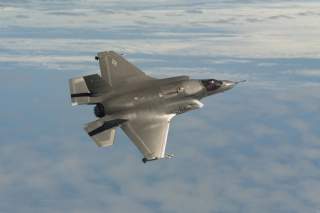Italy Is Prepping Its Only Aircraft Carrier to Handle F-35B Stealth Fighters
More and more nations are adopting the 5th generation plane.
Cavour, Italy’s only aircraft carrier, is designed to accommodate up to 12 F-35B stealth jump jets.
In theory. In reality, actually operating the stealth fighters requires Cavour to undergo some significant modifications.
Although conceptually similar to the smaller Harrier jump jet that already flies from Cavour, the Lockheed Martin F-35B produces much more heat than the older Boeing fighter does.
During takeoff and landing, the F-35B’s thrust peaks at 186 kilonewtons. By contrast, the most powerful engine ever installed in a Harrier, the Pegasus 11-61/Mk.107, generates just 106 kilonewtons.
Thus navies hoping to transition from the Harrier to the F-35B have had to re-coat their carriers’ decks for improved thermal protection.
The standard modification involves the addition of supplementary intercostal structural elements at the landing points, resulting in the displacement of the pre-existing elements — lighting, ventilation, piping — and the redesigning of certain interior spaces.
The addition of Thermion — an expensive, heat-resistant and non-slip coating — is imperative.
To date, three countries have ordered the F-35B for use from ships. Italy is buying 30. The United Kingdom wants 138 units for its new Queen Elizabeth-class carriers and the United States is buying 350 for the Marine Corps, which routinely deploys jump jets aboard Navy assault ships.
Australia has decided not to purchase the F-35B for its two helicopter carriers because of the enormous cost of modifying the ships with new radars, landing systems, reinforced structures and changes to fuel storage and the hangars.
The Royal Navy has already taken steps to modify HMS Queen Elizabeth and her sister ship Prince of Wales. Each 280 meters long and displacing 64,000 tons of water, the British carriers can accommodate 36 F-35Bs apiece.
Queen Elizabeth’s sea trials should begin in 2017. Her air wing could come aboard as early as 2018 in order to prepare for the ship’s first operational patrol in 2020. Prince of Wales should reach each milestone 18 months later.
The U.S. Navy has recently finished modifying the new assault ship USS America for F-35B operations. The major changes concerned the flight deck’s thermal protection. Sister vessel Tripoli is still in the shipyard, but all the F-35B modifications — a thicker deck and stronger structural supports — have already been implemented.
The Navy should take delivery of Tripoli in 2019.
Finally, Italy. Of the 15 F-35Bs the Italian navy is acquiring and 15 that the air force wants to buy, three will be permanently located in the United States for testing. The balance of 27 F-35Bs should be adequate to form an air wing of a dozen planes.
Assuming Cavour can handle the stealth fighters, that is. The 28,000-ton vessel launched in 2004, long before the F-35B’s take-off, landing and support requirements were well known.
Now, Cavour’s flight deck coating is already thicker than the equivalent coating on older American assault ships. That should help ease Cavour’s transition to F-35B operations. Still, rework could cost millions of dollars.
Rome believes the F-35Bs are worth it. The stealth fighters will give Cavour’s air wing capabilities that it lacks with its current Harriers — perhaps most importantly, the ability to suppress enemy air defenses.
Plus, the Italian navy is planning on boosting the size of Cavour’s air wing. Where today the carrier supports just eight Harriers, in coming years it could deploy with as many as a dozen F-35Bs.
Italy wants its F-35Bs to be combat-ready by 2023. Cavour will need to be ready for the new planes before then.
This first appeared in WarIsBoring here.

